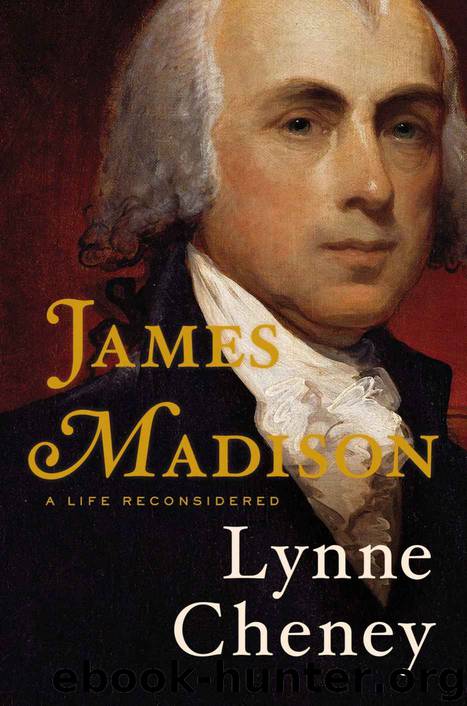James Madison: A Life Reconsidered by Lynne Cheney

Author:Lynne Cheney [Cheney, Lynne]
Language: eng
Format: epub, azw3
Publisher: Penguin Group US
Published: 2014-05-06T00:00:00+00:00
Chapter 13
THE REVOLUTION OF 1800
REPUBLICANS CLAIMED that Jefferson’s victory signified a revolution, by which they meant that the Federalists had been turned out and their policies rejected, but Margaret Bayard Smith, wife of the publisher of the National Intelligencer, caught a deeper meaning when she described Jefferson’s inaugural to her daughter: “I have this morning witnessed one of the most interesting scenes a free people can ever witness. The changes of administration, which in every government and in every age have most generally been epochs of confusion, villainy, and bloodshed, in this our happy country take place without any species of distraction or disorder.”1 The peaceful transfer of power from a party of one philosophy to that of another made Jefferson’s election and inauguration a turning point not just for the United States but for the world.
When James Madison arrived with his wife in the new capital in late April, he surely saw that it reflected the new direction of the country. Here there were no kingly gardens, no grand buildings lining palatial avenues—indeed, no avenues save the one named after Pennsylvania, and it was unpaved. The president’s house was an imposing building, but it stood on a barren plain, its grounds seeming “never to have been touched by spade or pick-axe,” a British visitor observed. As for the Capitol, rising on Jenkins Hill a mile and a half away, it consisted of two wings unconnected by a central structure, and only one of the wings was finished.2
Washington City wasn’t a city at all, which was fitting enough for a new administration that held up rural life as the American ideal. The new capital had “several points of natural beauty to recommend it,” a visitor observed, “the ground being elevated on both sides of the Potomac, and the views varied as well as in many parts romantic, particularly just above the city where the river is obstructed by rocks and at the Eastern Branch where there are fine woods and some delightful rides.” Cows grazed where the city’s planner, Pierre L’Enfant, envisioned grand plazas. Fields of corn grew not far from the president’s house. Such was Washington’s undeveloped state that the clusters of buildings here and there were mostly known not by street numbers but by how many buildings were in the group. Ask people where they lived and they might respond “Seven Buildings” or “Twenty Buildings.”3
As the Madisons rode up to the president’s house in their carriage, they would have seen that Jefferson was already remodeling, changing the entrance from the north side to the south. He was also having the wooden privy that had stood alongside the house torn down and installing water closets inside. He probably showed the new arrivals how he was changing around the way the rooms were used, pointed out the cornices he was upgrading and the location he had chosen for a wine cellar. The Madisons, used to his “putting up and pulling down” at Monticello, would not have been surprised at any of this.
Download
James Madison: A Life Reconsidered by Lynne Cheney.azw3
This site does not store any files on its server. We only index and link to content provided by other sites. Please contact the content providers to delete copyright contents if any and email us, we'll remove relevant links or contents immediately.
| American Revolution | Civil War |
| US Presidents |
Fanny Burney by Claire Harman(25785)
Empire of the Sikhs by Patwant Singh(22173)
Out of India by Michael Foss(16312)
Leonardo da Vinci by Walter Isaacson(11906)
Small Great Things by Jodi Picoult(6096)
The Six Wives Of Henry VIII (WOMEN IN HISTORY) by Fraser Antonia(4791)
The Wind in My Hair by Masih Alinejad(4425)
The Lonely City by Olivia Laing(4121)
The Crown by Robert Lacey(4105)
A Higher Loyalty: Truth, Lies, and Leadership by James Comey(4034)
The Iron Duke by The Iron Duke(3639)
Millionaire: The Philanderer, Gambler, and Duelist Who Invented Modern Finance by Janet Gleeson(3570)
Sticky Fingers by Joe Hagan(3454)
Alive: The Story of the Andes Survivors by Piers Paul Read(3313)
Papillon (English) by Henri Charrière(3270)
Joan of Arc by Mary Gordon(3260)
Stalin by Stephen Kotkin(3087)
Aleister Crowley: The Biography by Tobias Churton(3021)
Ants Among Elephants by Sujatha Gidla(2925)
